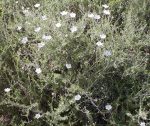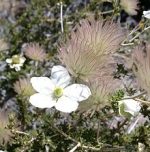 This twiggy, deciduous to semi-evergreen shrub is native to western US from southern California east to Arizona, New Mexico, and Texas where it grows in semidesert foothills, canyons, and arroyos. It is a member of the rose family, Rosaceae, that also includes cherry, almond, and lady’s mantle. Growing 3-8′ tall the plant has many thin branches with whitish stems and exfoliating bark. The dark green, hairy, pinnate leaves have silvery undersides and 3-7 lobes. They are up to 1/2″ long and have margins that roll under. In late spring and early summer solitary, white, 5-petaled flowers appear that are up to 2″ across and attractive to bees and butterflies. The flowers are followed by seed capsules with feathery lavender plumes up to 2″ long. Plants are heat and drought tolerant, a good source of forage for wildlife, effective for erosion control and a good choice for a border, native plant or wildlife garden especially in a xeriscape. The genus name, Fallugia, honors Abbot V. Fallugi of Vallombrosa, Italian botanist, c. 1627–1707. The specific epithet, paradoxa, is the Latin word meaning contrary to expectation.
This twiggy, deciduous to semi-evergreen shrub is native to western US from southern California east to Arizona, New Mexico, and Texas where it grows in semidesert foothills, canyons, and arroyos. It is a member of the rose family, Rosaceae, that also includes cherry, almond, and lady’s mantle. Growing 3-8′ tall the plant has many thin branches with whitish stems and exfoliating bark. The dark green, hairy, pinnate leaves have silvery undersides and 3-7 lobes. They are up to 1/2″ long and have margins that roll under. In late spring and early summer solitary, white, 5-petaled flowers appear that are up to 2″ across and attractive to bees and butterflies. The flowers are followed by seed capsules with feathery lavender plumes up to 2″ long. Plants are heat and drought tolerant, a good source of forage for wildlife, effective for erosion control and a good choice for a border, native plant or wildlife garden especially in a xeriscape. The genus name, Fallugia, honors Abbot V. Fallugi of Vallombrosa, Italian botanist, c. 1627–1707. The specific epithet, paradoxa, is the Latin word meaning contrary to expectation.
 Type: Deciduous to semi-evergreen shrub
Type: Deciduous to semi-evergreen shrub
Outstanding Feature: Plumed fruits
Form: Rounded
Growth Rate: Moderate to rapid
Bloom: White, 5-petaled flowers up to 2″ across in late spring to early summer
Size: 3-7′ H
Light: Full sun to partial shade
Soil: Average, dry, well-drained
Hardiness: Zones 5-10
Care: Prune as needed to enhance the form; cut oldest stems to the ground to rejuvenate.
Pests and Diseases: None of significance
Propagation: Seed, cuttings
Photo Credit: Stan-Shebs,Wikimedia Commons; Andrew Hart, Wikimedia Commons